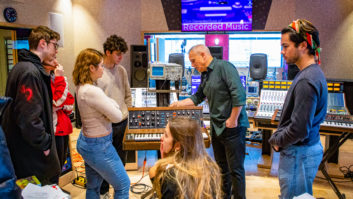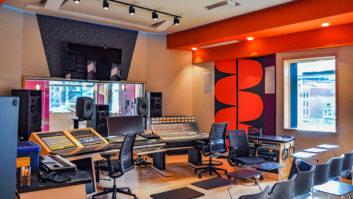
As a company started by a voiceover artist, it makes sense that New York City’s Creative Media Design would grow from that root. Owner/president Mike Zirinsky, who bought the company from voice actor Michael George back in 2013, recently expanded CMD with two new ventures: a voiceover coaching school called The Voice Shop, and CB Radio Tours, which offers clients the opportunity to promote their brand via interviews on national radio.
“I’m always open to exploring new business opportunities,” Zirinsky says, “whether it’s specific to casting and recording, or whether it is another business altogether.”
Keeping a studio alive in New York City isn’t easy, so Zirinsky and his team try to ascertain their current clients’ needs, as well as formulate ways to reach new clients. He adds, “I’m open to taking some educated risks, knowing that there is a demand out there. We have the infrastructure here to make use of our studios in different ways, other than what the traditional sense would be.”
As evident from their motto: ‘‘Cast. Record. Mix.” CMD is not just a casting company. It’s a full-service audio post facility, offering clients everything for casting, recording, sound design, music services and 5.1 surround mixing. The company recently moved to a new facility on 37th Street in midtown Manhattan. Their new digs occupy the building’s entire top floor and Studio A offers clients a rare treat in the audio post world—sunlight!
“We worked with Tim Crossley of Crossley Acoustics when designing the facility,” says Bob Kirschner, chief audio engineer. “We all decided to put Studio A under the large skylight. We wanted to create a very comfortable room, and Studio A is flooded with natural light,”
The new facility houses four studios, two of which CMD operates regularly and two that are rented out. Kirschner, who engineers in Studio A, helped to guide the gear selection for the facility. In many regards, the studios are technical twins. Each has a Mac Pro running Pro Tools 10 HD with identical plug-in packages. On the vocal recording chain, both studios use a Great River ME-1NV mic preamp and a Crane Song Trakker compressor.
“I wanted to have two studios that were as mirrored as much as possible,” says Kirschner.
“At our old place it was very difficult to have a session start in Studio A and then move over to Studio B to continue work on it. Now, projects can pass between the rooms with ease.”
But there are still differences between the rooms. Studio A is set up for 5.1 surround mixing while Studio B remains stereo for now. Also, Studio A uses an Avid Icon D-Control surface for mixing while Studio B relies on the keyboard-and-mouse. Kirschner chose the D-Control specifically because of its “dedicated EQ and compressor controls right in the center of the console. On the Avid S6 console, it’s all virtual knobs and everything is touchscreen. There aren’t dedicated knobs, and that’s something I feel is lacking with the S6.”

CMD owner Mike Zirinsky, left, and chief audio engineer Bob Kirschner.
Another key difference is the mic choice. Studio A’s VO booth houses a Neumann M 149 as its main mic while Studio B’s booth is equipped with a Neumann TLM 49. When George started CMD in 1998, he chose the M 149 tube mic, but since it’s quite pricey, Kirschner opted for its solid- state counterpart, the TLM 49, which produces a comparable sound for less. “The TLM 49 has a very similar tone to the M 149 but without the tube warmth. We find we can go back and forth between the two studios without too much of an issue,” says Kirschner.
Before joining the CMD staff in 2013, Kirschner owned City Sound Productions in lower Manhattan, which began as a project studio geared toward musicians. [Note: City Sound Productions was designed by Francis Manzella and was featured on the cover of Mix in June 1993.]
Eventually, Kirschner’s studio transitioned to audio post in collaboration with his wife, a filmmaker. His studio began to feed the need of a steady stream of filmmakers who rented their Avid editing suites. Working mainly on documentary films, Kirschner built up his dialog editing and mixing chops. After 13 years of studio ownership, Kirschner says inevitably “a one-room studio in Manhattan was really hard to keep afloat.” So he closed up shop and went freelance as an audio post mixer, working at places such as Food Network and TruTV, then finally finding a home at CMD. With his years of editing and mix-to-picture experience, Kirschner fit perfectly with a company that had voiceover at its core and audio post as its new focus.
CMD specializes in casting a wide range of voice talent, from regional-dialect specific English to numerous foreign languages and accents, and even regional-dialect specific foreign languages. They enlist talent from across the country and the globe, but Kirschner notes most clients like having face-to-face contact with their talent. Fortunately, “New York City is the best place to be if you need a diverse talent pool,” he says. “For instance, we do a lot of Haitian Creole, and there’s a Caribbean community in Brooklyn to draw from. We’ve developed this niche where we are very strong in foreign-language projects. Ad agencies know that we can cast spots in Japanese, or Mandarin, or Thai, and accommodate the regional emphasis that they want.”
Recently, while working with ad agency Wider Lens on a campaign for CHEP, an international shipping company, CMD needed to cast talent for 19 languages because the rebranding video was being distributed to all major shipping ports around the world. “Basically any country that has a port, CHEP has a station there. In every region there was a local person that was involved with the translation and the approval of the voiceover for the video,” says Kirschner. “At first we were recording much of the voiceover without regional input, and most of it went really well. But there were a few regions that had specific requirements, namely Belgium and France.”
Particular emphasis was placed on inflection and accent, so Kirschner waited to record the Belgium and French sessions at a time when the local CHEP rep could be on the phone to listen in and give immediate feedback. “We had someone on the phone from Belgium during the recording. We worked in-session with a language supervisor and the talent. And our clients from Wider Lens were here to give the direction. It was an interesting process,” he says.
With their new venture, The Voice Shop, CMD can grow its talent base in New York. The business is able to discover new talent and to help its existing talent base polish their skills. Kirschner explains: “Our talent pool is primarily non-union actors. We have really strong relationships not only with English voice talent but also with international/foreign language speaking talent here in the city.”
Zirinsky adds, “The Voice Shop is a standalone voice coaching school, but it’s tied into CMD. Not only can we help coach the talent but we can also give them an outlet to potentially get some work. That translates well for our clients because we are continuously able to offer them fresh voices that they probably wouldn’t have exposure to.”







